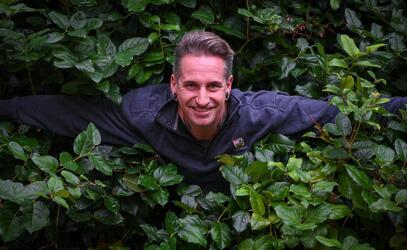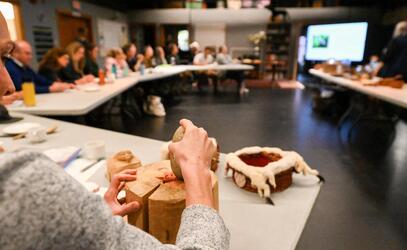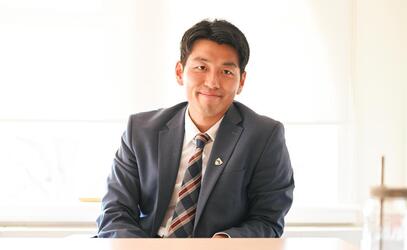Every year, we are honoured to recognize members of the SMUS community as they retire and take on new adventures. Read the series to learn more about their outstanding contributions to the school. This week, we recognize Mike Jackson, former Senior School teacher.
Mike Jackson
Brown Hall was abuzz with energy – kinetic and otherwise – on the last day of school in June 2019. The Grade 9s were demonstrating their designs for harnessing human power to charge a cellphone. As students and staff explored the projects, Mike Jackson was on hand to listen, learn and, as to be expected, teach.
It was his last official day after a 33-year teaching career at St. Michaels University School.
“So many of them had success, not just in terms of having a successful project, but all of them had learned something about themselves,” he says. “And they learned that making stuff work isn’t as simple as it sounds.”
With more than three decades devoted to teaching and the SMUS community, Mike has seen the school grow and evolve. From his first day to delivering his final lesson, he has been a vital part of the school community, known for introducing new ideas and moving the school’s science program forward to address the needs of a changing world and the interests of students.
“Over a lengthy career, it’s easy to find your niche. However, there are some whose nature is to never stop exploring, to continue looking for opportunities to learn new skills and technologies that they can share with their colleagues and that they can use to better prepare their students for the future,” says Peter Leggatt, a fellow SMUS science teacher. “Mike Jackson clearly falls into this group.”
Building the science program
He started the Middle School science program and was the head of the Senior School science department for 25 years. He also introduced new science curriculum at the Senior School (environmental science, marine science, earth sciences and geology to name a few subjects).
“Those subjects are where traditional sciences intersect with the real world for a lot of people,” he says. “When you start looking at earth sciences, that’s all about the environment around you. Understanding how it all relates is important.”
As the subjects offered grew, the school changed too. When Mike started, the classrooms were what he describes as “traditional” and lacking lab space to support hands-on learning. The purpose-built science building in 1994 really changed the learning landscape, he says.
“We were able to set up the classrooms for the way we were teaching – with an area that was lecture focused and another that was activity focused,” he says.
New ways of teaching saw more opportunities for students to learn in the environment they were studying. Mike designed a four-day intensive field and lab experience to Bamfield Marine Sciences Centre near Pacific Rim National Park for students.
“It was a natural fit for the course,” he says. “It was very hands-on.”
His desire to help students learn in nature saw him actively involved in the Outdoor Leadership program. Kayaking adventures with the Grade 10s as part of the Experiential Program used the environment as a vehicle for teaching. And the changing realities of an outside classroom meant the learning came naturally.
“Adapting teaching to whatever is happening makes it relevant and interesting,” he says.
Taking the learning online
Finding better ways to do things is always front of mind for Mike, who is known for seeking out technology to enhance learning experiences. From introducing a digital plate tectonics simulation in the early 1990s to teaching students how to analyze data through Excel and mine the Internet for information, he is a firm believer that technology has an important role to play in connecting people to knowledge, and in many cases to nature itself.
“It allows me to experience the natural world more fully,” he says. “Whether it is digital photography or measurement tools, we can map and measure and study in ways that just weren’t possible before.”
His interest in technology extended to helping his colleagues as well. He launched the school’s first digital reporting system and online academic network for faculty, and had a reputation for introducing new apps and platforms for teachers to use. His innovative efforts earned him a Prime Minister’s Certificate of Achievement for teaching excellence in 2002.
A career spent learning
His time at SMUS is over, but his role as a teacher is not. What was a part-time job during summers and holidays has turned into contracts taking him from the B.C. coast to Iceland, the Arctic, Antarctic and the equator serving as a natural history guide where he will continue learning and sharing his knowledge. There will also be time to update the next edition of his book, Galapagos: A Natural History.
“I enjoyed every year that I have been at the school. Being involved in the growth has been very rewarding,” he says. “The school has been my life for the last 33 years, and the life of my family too.”
His wife Monica Jackson worked at SMUS for 24 years, supporting a number of roles in the science department. Their daughters – Jenny ’08 and Claire ’10 – were Lifers attending from Kindergarten through Grade 12, and for eight years the whole family lived in Barnacle House, with Michael and Monica serving as senior houseparents.
“Working at a school like this is rewarding,” he says. “It’s a life choice rather than a career choice.”


